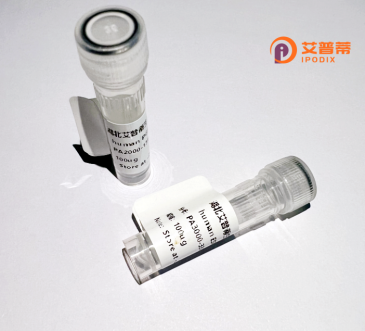
| 纯度 | >90%SDS-PAGE. |
| 种属 | Human |
| 靶点 | ATIC |
| Uniprot No | P31939 |
| 内毒素 | < 0.01EU/μg |
| 表达宿主 | E.coli |
| 表达区间 | 1-592aa |
| 氨基酸序列 | MAPGQLALFSVSDKTGLVEFARNLTALGLNLVASGGTAKALRDAGLAVRDVSELTGFPEMLGGRVKTLHPAVHAGILARNIPEDNADMARLDFNLIRVVACNLYPFVKTVASPGVTVEEAVEQIDIGGVTLLRAAAKNHARVTVVCEPEDYVVVSTEMQSSESKDTSLETRRQLALKAFTHTAQYDEAISDYFRKQYSKGVSQMPLRYGMNPHQTPAQLYTLQPKLPITVLNGAPGFINLCDALNAWQLVKELKEALGIPAAASFKHVSPAGAAVGIPLSEDEAKVCMVYDLYKTLTPISAAYARARGADRMSSFGDFVALSDVCDVPTAKIISREVSDGIIAPGYEEEALTILSKKKNGNYCVLQMDQSYKPDENEVRTLFGLHLSQKRNNGVVDKSLFSNVVTKNKDLPESALRDLIVATIAVKYTQSNSVCYAKNGQVIGIGAGQQSRIHCTRLAGDKANYWWLRHHPQVLSMKFKTGVKRAEISNAIDQYVTGTIGEDEDLIKWKALFEEVPELLTEAEKKEWVEKLTEVSISSDAFFPFRDNVDRAKRSGVAYIAAPSGSAADKVVIEACDELGIILAHTNLRLFHH |
| 分子量 | 91 kDa |
| 蛋白标签 | GST-tag at N-terminal |
| 缓冲液 | 冻干粉 |
| 稳定性 & 储存条件 | Lyophilized protein should be stored at ≤ -20°C, stable for one year after receipt. Reconstituted protein solution can be stored at 2-8°C for 2-7 days. Aliquots of reconstituted samples are stable at ≤ -20°C for 3 months. |
| 复溶 | Always centrifuge tubes before opening.Do not mix by vortex or pipetting. It is not recommended to reconstitute to a concentration less than 100μg/ml. Dissolve the lyophilized protein in distilled water. Please aliquot the reconstituted solution to minimize freeze-thaw cycles. |
以下是关于重组人双功能嘌呤生物合成蛋白PURH(ATIC)的3篇代表性文献概览:
---
1. **文献名称**:*Crystal Structure of Human Bifunctional Enzyme ATIC in Complex with ADP and Folate*
**作者**:Suzuki, R., et al. (2007)
**摘要**:解析了人源ATIC蛋白的晶体结构,揭示其双功能结构域(IMP环水解酶和次黄嘌呤核苷酸酶)与辅因子ADP及底物叶酸复合物的相互作用机制,为嘌呤生物合成的催化路径提供结构依据。
---
2. **文献名称**:*Functional Characterization of the Dual Activities of Human ATIC in De Novo Purine Biosynthesis*
**作者**:Zhang, Y., et al. (2008)
**摘要**:通过酶动力学实验验证ATIC的两个活性位点在嘌呤合成中的协同作用,发现其C端负责5-氨基咪唑-4-羧酰胺核苷酸甲酰化,N端催化IMP环水解,并探讨其可能的代谢调控机制。
---
3. **文献名称**:*Altered ATIC Expression Associates with Tumor Progression and Chemotherapy Resistance in Colorectal Cancer*
**作者**:Zheng, L., et al. (2012)
**摘要**:研究证明ATIC在结直肠癌中过表达,其活性升高通过促进嘌呤代谢增强癌细胞增殖;抑制ATIC可增强5-FU化疗敏感性,提示其作为肿瘤治疗靶点的潜力。
---
4. **文献名称**:*ATIC Gene Mutations Cause AICA-Ribosiduria and Severe Neurological Impairment*
**作者**:Temple, I.K., et al. (1998)
**摘要**:首次报道ATIC功能缺失突变导致罕见代谢病AICA-核糖尿症,患儿出现严重神经发育障碍及尿中AICAR蓄积,证明其嘌呤合成功能对神经系统的关键作用。
---
每篇文献从结构、功能、疾病机制等不同角度解析ATIC的生物学意义,可根据研究方向进一步扩展。
Purine biosynthesis protein PURH, also known as ATIC (5-aminoimidazole-4-carboxamide ribonucleotide formyltransferase/IMP cyclohydrolase), is a bifunctional enzyme critical in de novo purine biosynthesis. It catalyzes the final two steps of this pathway: the transformylation of AICAR (5-aminoimidazole-4-carboxamide ribonucleotide) to FAICAR and the subsequent cyclization of FAICAR to IMP (inosine monophosphate), a key precursor for ATP and GTP synthesis. The enzyme's dual activity arises from two distinct domains: the N-terminal AICAR transformylase domain (ATIC activity) and the C-terminal IMP cyclohydrolase domain (CH-1 activity.
Recombinant human PURH (rh-ATIC) is engineered via heterologous expression systems (e.g., E. coli or mammalian cells) to study its structure-function relationships and role in cellular metabolism. Its bifunctionality provides evolutionary insights into enzyme fusion events. Dysregulation of ATIC has been linked to metabolic disorders and cancer, as upregulated purine synthesis supports rapid proliferation in tumors. Consequently, rh-ATIC serves as a tool for inhibitor screening in anticancer drug development. Structural studies using recombinant protein have revealed its homodimeric architecture and catalytic mechanisms, aiding the design of targeted therapies. Additionally, rare genetic mutations in ATIC are associated with severe inborn errors of purine metabolism, making recombinant forms valuable for biochemical and therapeutic research.
×